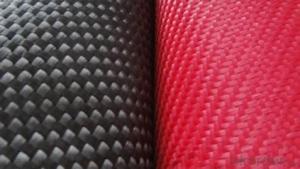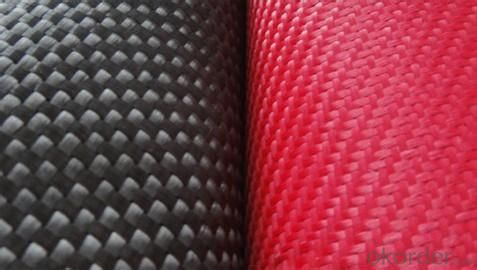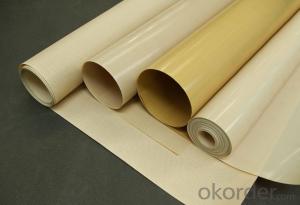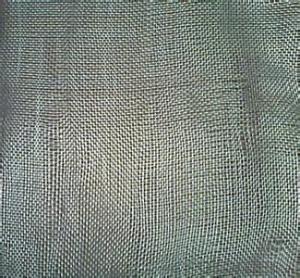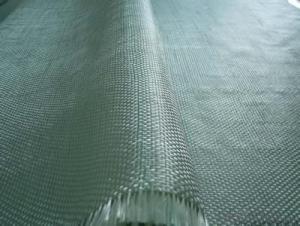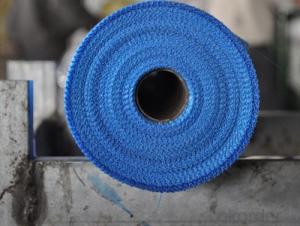High Silica Fiberglass cloth
- Loading Port:
- China Main Port
- Payment Terms:
- TT OR LC
- Min Order Qty:
- -
- Supply Capability:
- -
OKorder Service Pledge
OKorder Financial Service
You Might Also Like
Specifications
High-silica fiberglass is a kind of inorganic fiber that is characterized by its resistance to high temperatures.
1High-silica fiberglass is a kind of inorganic fiber that is characterized by its resistance to high temperatures. Its softening point approaches 1700 and can be used at 900 for a long time. The fabric is applicable for use as a heat-resitant,fire-resitant,and corrosion resistant material in the construction of rockets, missilesand other space vehicles. Apart from applications requiring high temperature-resistance, it is also has insulation and fire prevention uses.
2This product conform with the GJB 1873-94 nation military standard. SPECIFICATION: SiO2>96%, LOI<3%. Our company has plain weave and satin weave, thickness is 0.1-1.5mm.
Application:
High temperature resistant, insulation and sealing material
High temperature ablation resistant material
Fireproof material(fireproof cloth, fireproof curtain, fire blanket)
Dust collecting in media of high temperature gas and filtration in media of high temperature liquid
Filer for molten metal
Distinguisher, insulation material, filtration of automobile and motorcycle
Protective material for welding
Electricity insulation material
- Q: What are the different fiberglass fabric weights for lightweight applications?
- Fiberglass fabric weights for lightweight applications come in various options. These weights are typically measured in ounces per square yard (oz/yd²) and range from very light to slightly heavier. One of the lightest choices is a 3 oz/yd² fiberglass fabric, which finds common usage in applications where weight is critical. This weight is suitable for aerospace components, lightweight structures, and automotive parts. Another weight commonly used for lightweight applications is the 4 oz/yd² fiberglass fabric. It offers a slightly higher level of strength and durability compared to the 3 oz/yd² fabric, while still being lightweight. It is often employed in boat construction, sporting goods, and automotive body panels. For applications demanding more strength and rigidity, a 6 oz/yd² fiberglass fabric may be utilized. This weight remains relatively lightweight but provides a higher level of reinforcement. It is commonly found in wind turbine blades, construction, and marine applications. Lastly, a 9 oz/yd² fiberglass fabric is considered relatively heavy for lightweight applications, but it still falls within the lightweight category. This weight offers greater strength and durability, making it suitable for industrial equipment, tanks, and heavy-duty structures. It is important to note that these weight categories are general guidelines, and the specific requirements of each application may vary. Seeking advice from a fiberglass fabric supplier or manufacturer can give more specific recommendations based on the intended use and desired performance of the lightweight application.
- Q: Is fiberglass fabric suitable for use in aerospace composites?
- Yes, fiberglass fabric is suitable for use in aerospace composites. It offers excellent strength-to-weight ratio, good resistance to temperature variations, and high mechanical properties, making it a popular choice for reinforcing composite materials used in aerospace applications. Additionally, fiberglass fabric can be easily manufactured and molded into complex shapes, further enhancing its suitability for aerospace composites.
- Q: Can fiberglass fabric be used for making protective sleeves and gloves?
- Protective sleeves and gloves can be made using fiberglass fabric, which is renowned for its outstanding resistance to heat, durability, and insulation properties. These attributes render it appropriate for tasks necessitating protection against elevated temperatures, sparks, and molten metal. The utilization of fiberglass fabric in the production of protective sleeves and gloves ensures a dependable shield against heat and flames. It can endure temperatures of up to 1000 degrees Fahrenheit, making it particularly well-suited for sectors like welding, foundries, and glass manufacturing. Moreover, fiberglass fabric boasts wear-resistance, tear-resistance, and excellent tensile strength, guaranteeing that the resulting protective sleeves and gloves are long-lasting and offer reliable protection. Furthermore, the fabric is lightweight and flexible, facilitating ease of movement and dexterity, which is crucial for tasks requiring fine motor skills. Nevertheless, it is worth noting that fiberglass fabric has the potential to cause skin irritation. Consequently, it is frequently coated or lined with other materials to prevent direct contact with the skin. This lining or coating not only enhances comfort but also provides supplementary protection against potential skin allergies or irritation. In conclusion, fiberglass fabric proves to be a suitable material for the production of protective sleeves and gloves due to its heat resistance, durability, and insulation properties. It offers dependable defense against high temperatures, sparks, and molten metal, making it an exceptional choice for individuals employed in industries exposed to heat and flame hazards.
- Q: What is the basis of testing polyester glass fiber cloth?
- Polyester fiber glass fabric has its own material properties, so it can be crushed and recycled. When milling, the polyester fiberglass fabric is crushed into very small fibers. This can actually increase the performance of the recycled material. Other fabric cracks can sometimes be glued to the milling machine, resulting in costly shutdowns.
- Q: How do fiberglass fabrics perform in terms of chemical resistance?
- Fiberglass fabrics generally exhibit excellent chemical resistance. The inherent properties of fiberglass, including its non-reactivity and stability, make it highly resistant to a wide range of chemicals. Fiberglass fabrics can withstand exposure to various corrosive substances, including acids, bases, solvents, and even some strong oxidizing agents. The chemical resistance of fiberglass fabrics can be attributed to the composition of the material, as they are typically made of glass fibers woven together. Glass fibers are non-absorbent and do not react with most chemicals, making them highly resistant to degradation or damage. However, it is important to note that the chemical resistance of fiberglass fabrics can vary depending on the specific type of resin used to bind the fibers together. Different resins may have different levels of resistance to certain chemicals. Therefore, it is crucial to consider the specific application and the intended chemical exposure when selecting a fiberglass fabric. In summary, fiberglass fabrics are generally known for their excellent chemical resistance. They can withstand exposure to a wide range of chemicals without experiencing significant degradation or damage. However, it is always advisable to consult the manufacturer's specifications and recommendations to ensure the chosen fiberglass fabric is suitable for the intended chemical environment.
- Q: Can fiberglass fabric be used for reinforcement?
- Yes, fiberglass fabric can be used for reinforcement. It is commonly used in various industries such as construction, automotive, aerospace, and marine for reinforcing materials like composites, concrete, plastics, and even paper. The high strength, durability, and resistance to heat and chemicals make fiberglass fabric an ideal choice for reinforcement purposes.
- Q: How is fiberglass fabric cut?
- Fiberglass fabric is typically cut using specialized tools such as scissors, utility knives, or rotary cutters. The fabric is laid flat on a cutting surface, and the desired shape or size is traced onto it. The cutting tool is then used to carefully follow the traced lines, ensuring a clean and precise cut. It is important to use sharp tools and take safety precautions due to the fibrous nature of the fabric.
- Q: How long does fiberglass fabric typically last?
- Fiberglass fabric is known for its durability and longevity, making it a popular choice for various applications. The lifespan of fiberglass fabric can vary depending on several factors, such as the quality of the fabric, its exposure to external conditions, and how well it is maintained. On average, fiberglass fabric can last anywhere from 10 to 30 years. However, with proper care and maintenance, it is possible for it to last even longer. Regular cleaning, preventing excessive exposure to harsh chemicals or extreme temperatures, and avoiding physical damage can significantly prolong the lifespan of fiberglass fabric. It is important to note that fiberglass fabric can become brittle and lose its structural integrity over time, especially if exposed to continuous high temperatures or harsh environmental conditions. Additionally, natural wear and tear can also contribute to its eventual deterioration. To ensure the longest possible lifespan for fiberglass fabric, it is advisable to follow the manufacturer's guidelines regarding maintenance and care. Regular inspections for signs of damage or wear, and prompt repairs or replacements when necessary, can help extend the life of fiberglass fabric.
- Q: Is fiberglass fabric resistant to insects?
- Generally, insects are not attracted to or able to consume fiberglass fabric. It is made from woven strands of glass fibers, which do not appeal to insects. Moreover, fiberglass fabric does not create a suitable environment for insects to nest or breed because it is non-porous and does not retain moisture. As a result, it is a popular choice for insect screens and protective covers since it effectively keeps insects out without the need for chemical insecticides. However, it is essential to note that although fiberglass fabric itself resists insects, insects may still find their way through the seams and openings in the fabric. Consequently, proper installation and maintenance are crucial for ensuring complete insect resistance.
- Q: Is fiberglass fabric suitable for use in filtration systems?
- Fiberglass fabric is indeed appropriate for utilization in filtration systems. Renowned for its resistance to high temperatures, chemicals, and long-lasting nature, fiberglass proves to be an exceptional option for filtration systems demanding a material capable of enduring severe circumstances. Frequently employed in air filters, water filters, and industrial filtration applications, fiberglass fabric displays remarkable filtration efficiency as it proficiently captures and eliminates particles and impurities from fluids and gases. Moreover, fiberglass fabric can be tailored with ease to fulfill distinct filtration prerequisites, be it altering pore sizes or thicknesses. All in all, fiberglass fabric emerges as a dependable and efficient material for filtration systems.
Send your message to us
High Silica Fiberglass cloth
- Loading Port:
- China Main Port
- Payment Terms:
- TT OR LC
- Min Order Qty:
- -
- Supply Capability:
- -
OKorder Service Pledge
OKorder Financial Service
Similar products
Hot products
Hot Searches
Related keywords
